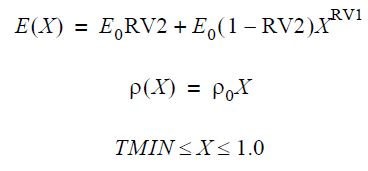Power Rule—the Relationship between Design Variables and Material Properties
GENESIS uses the density based method to solve the topology optimization problem. This method requires the creation of relationships between the design variables and the materials.
The typical relationship (POWER rule, which is the GENESIS default) is:
where
E(X) - Young’s modulus

- Initial Young’s modulus (this is the value in MAT1)

- Density

- Initial density (this is the value in MAT1)
X - Topology design variables which represents the element density (volume fraction)
TMIN - Minimum value of the topology design variable
RV1 - User-defined real value (Typically: 2.0 < RV1 < 3.0)
RV2 - Real parameter representing

, where

is the minimum value Young’s modulus is allowed to take. (0.0 < RV2 < 1.0, typically RV2=10
-6 which is the default)
These equations create a heuristic relationship between the Young’s modulus and the density. In theory the relationships are true only if the design variables are 0.0 or 1.0. If a design variable is 1.0, then it means that its corresponding element is needed. If the design variable is 0.0, then its corresponding element is not needed, and therefore it can be taken out of the model.


 - Initial Young’s modulus (this is the value in MAT1)
- Initial Young’s modulus (this is the value in MAT1) - Density
- Density - Initial density (this is the value in MAT1)
- Initial density (this is the value in MAT1) , where
, where  is the minimum value Young’s modulus is allowed to take. (0.0 < RV2 < 1.0, typically RV2=10-6 which is the default)
is the minimum value Young’s modulus is allowed to take. (0.0 < RV2 < 1.0, typically RV2=10-6 which is the default)